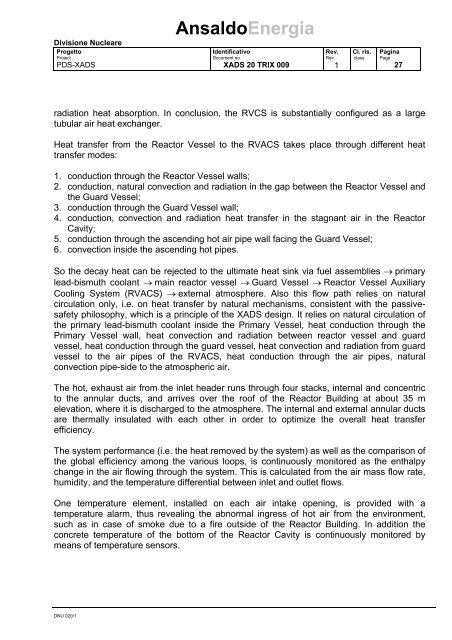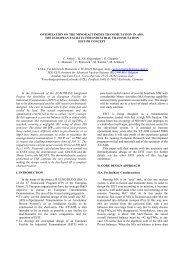AnsaldoEnergia
AnsaldoEnergia - KIT
AnsaldoEnergia - KIT
- No tags were found...
Create successful ePaper yourself
Turn your PDF publications into a flip-book with our unique Google optimized e-Paper software.
Divisione Nucleare<br />
Progetto<br />
Project<br />
PDS-XADS<br />
<strong>AnsaldoEnergia</strong><br />
Identificativo<br />
Document no.<br />
XADS 20 TRIX 009<br />
Rev.<br />
Rev.<br />
1<br />
Cl. ris.<br />
class<br />
Pagina<br />
Page<br />
27<br />
radiation heat absorption. In conclusion, the RVCS is substantially configured as a large<br />
tubular air heat exchanger.<br />
Heat transfer from the Reactor Vessel to the RVACS takes place through different heat<br />
transfer modes:<br />
1. conduction through the Reactor Vessel walls;<br />
2. conduction, natural convection and radiation in the gap between the Reactor Vessel and<br />
the Guard Vessel;<br />
3. conduction through the Guard Vessel wall;<br />
4. conduction, convection and radiation heat transfer in the stagnant air in the Reactor<br />
Cavity;<br />
5. conduction through the ascending hot air pipe wall facing the Guard Vessel;<br />
6. convection inside the ascending hot pipes.<br />
So the decay heat can be rejected to the ultimate heat sink via fuel assemblies → primary<br />
lead-bismuth coolant → main reactor vessel → Guard Vessel → Reactor Vessel Auxiliary<br />
Cooling System (RVACS) → external atmosphere. Also this flow path relies on natural<br />
circulation only, i.e. on heat transfer by natural mechanisms, consistent with the passivesafety<br />
philosophy, which is a principle of the XADS design. It relies on natural circulation of<br />
the primary lead-bismuth coolant inside the Primary Vessel, heat conduction through the<br />
Primary Vessel wall, heat convection and radiation between reactor vessel and guard<br />
vessel, heat conduction through the guard vessel, heat convection and radiation from guard<br />
vessel to the air pipes of the RVACS, heat conduction through the air pipes, natural<br />
convection pipe-side to the atmospheric air.<br />
The hot, exhaust air from the inlet header runs through four stacks, internal and concentric<br />
to the annular ducts, and arrives over the roof of the Reactor Building at about 35 m<br />
elevation, where it is discharged to the atmosphere. The internal and external annular ducts<br />
are thermally insulated with each other in order to optimize the overall heat transfer<br />
efficiency.<br />
The system performance (i.e. the heat removed by the system) as well as the comparison of<br />
the global efficiency among the various loops, is continuously monitored as the enthalpy<br />
change in the air flowing through the system. This is calculated from the air mass flow rate,<br />
humidity, and the temperature differential between inlet and outlet flows.<br />
One temperature element, installed on each air intake opening, is provided with a<br />
temperature alarm, thus revealing the abnormal ingress of hot air from the environment,<br />
such as in case of smoke due to a fire outside of the Reactor Building. In addition the<br />
concrete temperature of the bottom of the Reactor Cavity is continuously monitored by<br />
means of temperature sensors.<br />
DNU 020/1





